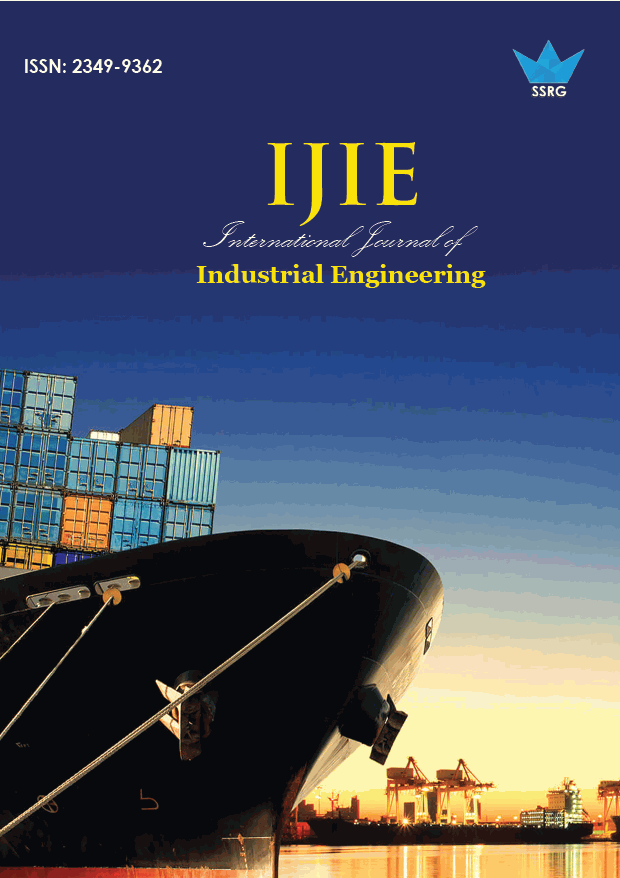Enhancing Operational Effectiveness in a Beverage Bottling SME through SMED, 5S, and TPM Maintenance Practices

| International Journal of Industrial Engineering |
| © 2025 by SSRG - IJIE Journal |
| Volume 12 Issue 3 |
| Year of Publication : 2025 |
| Authors : Diana Stella Rossi-Huamán, Billy Manfred Tecse-Villacorta, Richard Nicholas Meza-Ortiz |
How to Cite?
Diana Stella Rossi-Huamán, Billy Manfred Tecse-Villacorta, Richard Nicholas Meza-Ortiz, "Enhancing Operational Effectiveness in a Beverage Bottling SME through SMED, 5S, and TPM Maintenance Practices," SSRG International Journal of Industrial Engineering, vol. 12, no. 3, pp. 20-32, 2025. Crossref, https://doi.org/10.14445/23499362/IJIE-V12I3P103
Abstract:
Small and medium-sized enterprises in the Peruvian beverage sector faced persistent challenges of low productivity, frequent machine stoppages, and excessive reprocessing that limited their competitiveness. Previous studies highlighted the effectiveness of Lean Manufacturing and Total Productive Maintenance (TPM), but their combined application in bottling SMEs remained underexplored. This research addressed the urgent need to enhance operational efficiency by proposing an integrated model based on 5S, SMED, and TPM practices. The model was applied to a bottling company in Lima, where effectiveness had reached only 68% of the expected benchmark, generating annual losses equivalent to 34% of sales. Implementation reduced changeover times, improved workplace order, and increased equipment availability, yielding measurable gains in throughput and reliability. These outcomes demonstrated not only academic relevance by filling a gap in industrial engineering literature but also socioeconomic impact by strengthening SME competitiveness. The findings encourage further exploration of dual Lean TPM strategies in similar contexts.
Keywords:
SMED Implementation, 5S Methodology, TPM Maintenance, Operational Effectiveness, Beverage Industry SMEs.
References:
[1] Giuliano Almeida Marodin, and Tarcisio Abreu Saurin, “Implementing Lean Production Systems: Research Areas and Opportunities for Future Studies,” International Journal of Production Research, vol. 51, no. 22, pp. 6663-6680, 2013.
[CrossRef] [Google Scholar] [Publisher Link]
[2] Manoj Dora et al., “Application of Lean Practices in Small and Medium-Sized Food Enterprises,” British Food Journal, vol. 116, no. 1, pp. 125-141, 2013.
[CrossRef] [Google Scholar] [Publisher Link]
[3] Rui Borges Lopes, Filipa Freitas, and Inês Sousa, “Application of Lean Manufacturing Tools in the Food and Beverage Industries,” Journal of Technology Management & Innovation, vol. 10, no. 3, pp. 120-130, 2015.
[CrossRef] [Google Scholar] [Publisher Link]
[4] Bianca Joyce Vargas-Romero et al., “Enhancing Production Efficiency and Quality in the Carbonated Beverage Industry: A Lean Manufacturing Approach,” 9th North American Conference on Industrial Engineering and Operations Management, pp. 820-827, 2024.
[CrossRef] [Google Scholar] [Publisher Link]
[5] Esthefani Capcha-Huamali et al., “A Lean Manufacturing and RCM-Based Production Process Improvement Model for Increasing the Production Capacities of Carbonated Beverage Bottling Companies,” Advances in Manufacturing, Production Management and Process Control, vol. 274, pp. 464-472, 2021.
[CrossRef] [Google Scholar] [Publisher Link]
[6] António Carrizo Moreira, and Gil Campos Silva Pais, “Single Minute Exchange of Die: A Case Study Implementation,” Journal of Technology Management & Innovation, vol. 6, no. 1, pp. 129-146, 2011.
[CrossRef] [Google Scholar] [Publisher Link]
[7] Genett Isabel Jiménez-Delgado et al., “Lean Philosophy ‘Quick Wins’: A Case Study in a Non-alcoholic Beverage Company,” Digital Human Modeling and Applications in Health, Safety, Ergonomics and Risk Management, vol. 14709, pp. 279-294, 2024.
[CrossRef] [Google Scholar] [Publisher Link]
[8] Hubert Kędziora, and Justyna Trojanowska, “Application of Single Minute Exchange of Die Tool in a Food Industry Company to Eliminate Waste,” MATEC Web of Conferences, vol. 343, pp. 1-10, 2021.
[CrossRef] [Google Scholar] [Publisher Link]
[9] Renzo Peralta-Pereda et al., “Application of Lean-Total Productive Maintenance Tools to Reduce Setup Times and Machine Stoppages on the Molding Line of an SME in the Food Industry,” International Journal of Engineering and Technology, vol. 15, no. 4, pp. 138-143, 2023.
[CrossRef] [Google Scholar] [Publisher Link]
[10] H.R. Zadry, and R. Darwin, “The Success of 5S and PDCA Implementation in Increasing the Productivity of an SME in West Sumatra,” IOP Conference Series: Materials Science and Engineering, vol. 1003, pp. 1-9, 2020.
[CrossRef] [Google Scholar] [Publisher Link]
[11] David Rahmad Iswidibyo et al., “Developing Autonomous Maintenance through FMEA-RCM Models to Reduce % Machine Breakdown in Food and Beverages Industry,” Proceedings of the 2nd International Conference on Inclusive Business in the Changing World ICIB, pp. 635-639, 2019.
[CrossRef] [Google Scholar] [Publisher Link]
[12] Jacob Sawai Ben, “Implementation of Autonomous Maintenance and its Effect on MTBF, MTTR, and Reliability of a Critical Machine in a Beer Processing Plant,” International Journal of Progressive Sciences and Technologies, vol. 31, no. 1, pp. 57-66, 2022.
[CrossRef] [Google Scholar] [Publisher Link]
[13] Gerald Kenechukwu Inyiama, and Sunday Ayoola Oke, “Maintenance Downtime Evaluation in a Process Bottling Plant,” International Journal of Quality & Reliability Management, vol. 38, no. 1, pp. 229-248, 2021.
[CrossRef] [Google Scholar] [Publisher Link]
[14] Rodrigo Kohata-Tirado, Santiago Morales-Arce, and Martin Collao-Diaz, “Production Model Based on 5S and SLP to Improve Efficiency in a Food Industry Company,” 4th African International Conference on Industrial Engineering and Operations Management, pp. 69-81, 2023.
[CrossRef] [Google Scholar] [Publisher Link]

 10.14445/23499362/IJIE-V12I3P103
10.14445/23499362/IJIE-V12I3P103